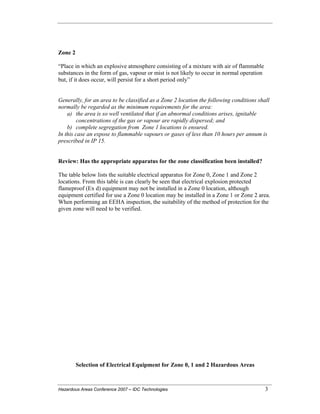How Roar Solutions can Save You Time, Stress, and Money.
How Roar Solutions can Save You Time, Stress, and Money.
Blog Article
Indicators on Roar Solutions You Need To Know
Table of ContentsThe 7-Minute Rule for Roar SolutionsExamine This Report on Roar SolutionsGetting The Roar Solutions To Work
In order to secure setups from a potential explosion a technique of analysing and categorizing a potentially hazardous area is required. The function of this is to guarantee the right selection and installment of equipment to eventually protect against an explosion and to make sure safety and security of life.
(https://www.brownbook.net/business/53579326/roar-solutions/)
No tools needs to be installed where the surface temperature of the equipment is above the ignition temperature level of the offered threat. Below are some usual dust dangerous and their minimal ignition temperature level. Coal Dust 380C 225C Polythene 420C (thaws) Methyl Cellulose 420C 320C Starch 460C 435C Flour 490C 340C Sugar 490C 460C Grain Dust 510C 300C Phenolic Material 530C > 450C Aluminium 590C > 450C PVC 700C > 450C Residue 810C 570C The probability of the risk being present in a concentration high adequate to create an ignition will vary from area to area.
In order to identify this danger a setup is split into locations of threat relying on the quantity of time the dangerous exists. These locations are described as Areas. For gases and vapours and dirts and fibers there are three areas. Zone 0 Area 20 A dangerous environment is extremely likely to be existing and may be existing for extended periods of time (> 1000 hours per year) and even continually Zone 1 Zone 21 A harmful atmosphere is feasible however not likely to be present for long periods of time (> 10 450 C [842 F] A category of T6 means the minimal ignition temperature is > 85 C [185 F] Harmful area electrical devices maybe developed for usage in greater ambient temperature levels. This would suggested on the rating plate e.g. EExe II C T3 Ta + 60C( This implies at 60C ambient T3 will not be surpassed) T1 T1, T2, T3, T4, T5, T6 T2 T2, T3, T4, T5, T6 T3 T3, T4, T5, T6 T4 T4, T5, T6 T5 T5, T6 T6 T6 A T Class ranking of T1 means the maximum surface temperature level created by the tool at 40 C is 450 C. Thinking the connected T Course and Temperature level score for the devices are suitable for the location, you can always utilize an instrument with a much more rigid Department rating than needed for the area. There isn't a clear answer to this concern. It really does rely on the kind of equipment and what repair services require to be brought out. Equipment with details test procedures that can't be carried out in the area in order to achieve/maintain 3rd party score. Should come back to the manufacturing facility if it is before the equipment's service. Area Fixing By Authorised Personnel: Difficult testing might not be needed however particular treatments might require to be complied with in order for the tools to maintain its 3rd celebration ranking. Authorized workers should be employed to perform the job properly Fixing need to be a like for find out like replacement. New element need to be taken into consideration as a direct replacement calling for no unique screening of the devices after the repair work is full. Each tool with a harmful rating need to be assessed individually. These are outlined at a high degree below, however for even more comprehensive details, please refer directly to the guidelines.
Some Ideas on Roar Solutions You Need To Know
The equipment register is a detailed database of equipment documents that consists of a minimum set of fields to identify each thing's area, technical specifications, Ex classification, age, and ecological data. The ratio of Detailed to Shut assessments will be identified by the Tools Threat, which is examined based on ignition risk (the probability of a resource of ignition versus the possibility of a combustible environment )and the dangerous location classification
( Zone 0Area 1, or 2). Carrying out a robust Risk-Based Evaluation( RBI )method is vital for making sure compliance and safety and security in handling Electric Equipment in Hazardous Locations( EEHA).
Roar Solutions Fundamentals Explained

In regards to explosive threat, a harmful area is an environment in which an eruptive ambience exists (or might be anticipated to be present) in amounts that need special preventative measures for the building, installation and usage of equipment. Roar Solutions. In this write-up we check out the challenges dealt with in the workplace, the danger control measures, and the called for competencies to function safely
It issues of modern life that we produce, save or deal with a range of gases or fluids that are regarded flammable, and a variety of dusts that are considered flammable. These compounds can, in particular conditions, develop eruptive atmospheres and these can have major and tragic effects. Most of us recognize with the fire triangular remove any type of among the three aspects and the fire can not take place, but what does this mean in the context of harmful locations? When breaking this down into its easiest terms it is basically: a combination of a specific amount of release or leak of a certain substance or material, blending with ambient oxygen, and the visibility of a resource of ignition.
In many circumstances, we can do little regarding the degrees of oxygen airborne, yet we can have substantial impact on resources of ignition, for instance electrical equipment. Hazardous areas are documented on the dangerous area category drawing and are identified on-site by the triangular "EX LOVER" sign. Here, amongst other crucial info, areas are split into three kinds relying on the threat, the probability and duration that an eruptive ambience will certainly exist; Area 0 or 20 is considered the most dangerous and Zone 2 or 22 is regarded the least.
Report this page